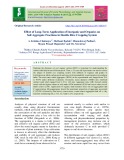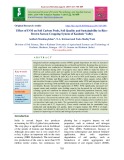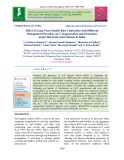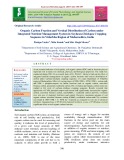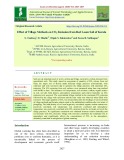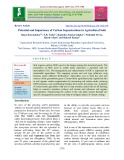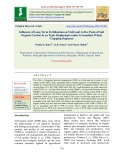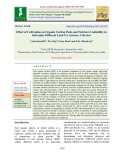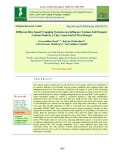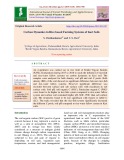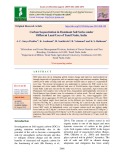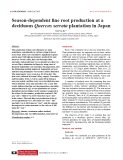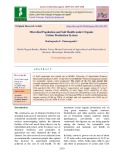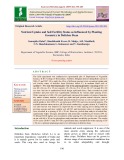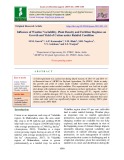
Soil organic carbon pools
-
Studying the dynamics of soil organic carbon (SOC) is important for understanding the carbon stabilization into different pools. Thus, a 25-year old experiment was used to assess the impact of double rice cropping system with addition of organics and grades of fertilization on labile carbon pools and crop yield sustainability in an Inceptisol in southern India. The total water stable aggregates (WSA) in the experimental soils ranged from 70.4 to 94.9% under different treatments.
 11p
11p  angicungduoc8
angicungduoc8
 07-11-2020
07-11-2020
 14
14
 1
1
 Download
Download
-
Integrated nutrient management system (INMS) gained importance not only in increased yield of crops but also in maintaining the soil health and fertility. Keeping these in views a field experiment was conducted at Mountain research centre for field crops Khudwani (SKUAST-Kashmir) during 2013 (in progress since march 2008) to study the Effect of INM on soil carbon pools and soil quality in rice-brown sarson cropping system with different treatment combinations.
 25p
25p  chauchaungayxua8
chauchaungayxua8
 03-10-2020
03-10-2020
 22
22
 2
2
 Download
Download
-
Studying the dynamics of soil organic carbon (SOC) is important for understanding the C stabilization into different pools. Carbon sequestration in soils has the potential to curb global warming besides maintaining sustainability of agricultural system under tropical and subtropical climate.
 8p
8p  chauchaungayxua8
chauchaungayxua8
 03-10-2020
03-10-2020
 11
11
 1
1
 Download
Download
-
The distribution of SOC with in different pools is an important consideration for understanding its dynamics and diverse role in ecosystems. Therefore, present study was carried out to study the effect of different options of nutrient management on active pools of SOC under soybean - chickpea cropping sequence of Typic Haplustepts.
 8p
8p  trinhthamhodang1215
trinhthamhodang1215
 23-09-2020
23-09-2020
 11
11
 1
1
 Download
Download
-
Impact of clay mineralogy on stabilization of soil organic carbon for long-term carbon sequestration
One of the largest sinks of organic carbon on the global scale is the organic matter stored in soils, it contains about 1500 Gt C in the top one meter. Changes in the size and the turnover rate of the soil carbon pools could possibly have an effect on the atmospheric CO2 concentration and the global climate. Stabilization of soil organic C (SOC) is pre-requisite for long-term C sequestration to mitigate climate change. Stabilization of SOC means the decrease in the potential loss of organic C by microbial respiration, erosion or leaching.
 11p
11p  cothumenhmong7
cothumenhmong7
 09-09-2020
09-09-2020
 22
22
 1
1
 Download
Download
-
Soils are an important pool of active carbon and tillage can lead to carbon emission from agricultural soils. This study aimed in assessment of quantity of CO2 release from red loam, the major soil of Kerala under different tillage practices (conventional, with cultivator and with rotovator) and to optimize the tillage practices with minimum CO2 emission. The CO2 emission from soil surfaces were measured using base trap method with NaOH as base.
 11p
11p  angicungduoc6
angicungduoc6
 22-07-2020
22-07-2020
 13
13
 2
2
 Download
Download
-
Soil organic carbon (SOC) pool is the largest among the terrestrial pools. The restoration of SOC pool in arable lands represents a potential sink for atmospheric CO2. The management and enhancement of SOC is important for sustainable agriculture. The cropping system and soil type influence crop biomass under different fertilization. Agriculture acts as both the sink and sources of the greenhouse gases.
 13p
13p  nguaconbaynhay6
nguaconbaynhay6
 24-06-2020
24-06-2020
 19
19
 1
1
 Download
Download
-
The effect of integrated nutrient management (INM) on yields and active pools of soil organic carbon (SOC) under groundnut-wheat cropping sequence of a Haplustepts soil was studied in a long term field experiment initiated since 1999 at Junagadh, Gujarat.
 14p
14p  trinhthamhodang1213
trinhthamhodang1213
 29-05-2020
29-05-2020
 10
10
 0
0
 Download
Download
-
Soil organic carbon (SOC) is an essential component of soil organic matter and being dynamic in nature controls the nutrients release as well as their availability. Different fractions of organic carbon plays different role in governing the nutrient availability. The various fractions of SOC includes- microbial biomass carbon (MBC), dissolved organic carbon (DOC), light and heavy fraction carbon pool.
 14p
14p  cothumenhmong5
cothumenhmong5
 17-05-2020
17-05-2020
 10
10
 0
0
 Download
Download
-
Soil organic matter content and several fractions of soil organic carbon are considered to be sensitive indicator of soil health who on several conditions like cropping choice and management practices. The presence of different soil organic C pool in rice cultivating soils are well documented but thoroughly studied information on relation between soil C status and different rice based cropping managements are not available.
 14p
14p  caygaocaolon4
caygaocaolon4
 04-04-2020
04-04-2020
 14
14
 0
0
 Download
Download
-
Short-term (after 3 crop cycle) field experiment was conducted to assess the effect of three tillage systems no tillage (NT), reduced tillage (RT) and conventional tillage (CT) and four crop rotations were selected, soybean + P. pea (S + PP, 2:1), soybean- wheat (S-W), maize + P. pea (M + PP, 1:1) and maize- gram (M - G) with their residue management (residue retained vs. burnt) on soil organic carbon fractions were study in a black soils (Vertisols) of Central India. Change in soil organic fractions influence in soil quality, health and carbon sequestration.
 14p
14p  trinhthamhodang4
trinhthamhodang4
 22-03-2020
22-03-2020
 18
18
 1
1
 Download
Download
-
An experiment was carried out in rice field of Krishi Vigyan Kendra (KVK), Kumarakom during 2017 to 2018 to study the influence of rice-fish and rice-water fallow systems on carbon dynamics in Kari soil. The samples were analysed for bulk density, soil pH and soil C pools. Bulk density (BD) of the soil showed no significant difference between rice-fish and rice-water fallow systems.
 7p
7p  caygaocaolon2
caygaocaolon2
 14-03-2020
14-03-2020
 5
5
 0
0
 Download
Download
-
SOC plays key role in mitigating global climate change and improves land productivity through improved soil properties such as nutrient supply and moisture retention. Studying carbon pools under existing land uses provides baseline data to project C sequestration over time. The present investigation was undertaken to estimate the SOC stock in two dominant soil series under different land uses of North-Eastern Agro-climatic zone of Tamil Nadu. Land uses selected for the study were Forests, Agriculture, Agro-forestry and Plantations.
 9p
9p  nguathienthan3
nguathienthan3
 27-02-2020
27-02-2020
 19
19
 0
0
 Download
Download
-
The field experiments were conducted at Nematology field, ICR Farm, AAU., Jorhat during 2016 and 2017 to know the efficacy of bioagent, P. fluorescens and biofertilizer, Azotobacter sp. for that P. fluorescens and Azotobacter sp. were enriched in the substrates like farmyard manure, vermicompost and enriched compost. After enrichment of P. fluorescens and Azotobacter sp. were applied singly and in combination at the rate of 1% per hectare (ha). These treatments were compared with untreated control. It was recorded that the combined application of P. fluorescens and Azotobacter sp.
 21p
21p  chauchaungayxua3
chauchaungayxua3
 07-02-2020
07-02-2020
 23
23
 2
2
 Download
Download
-
The production of fine roots (diameter ≤2 mm) contributes considerably to carbon cycling in forest ecosystems. Fine roots constitute a significant organic matter pool with high net primary productivity and turnover. In this study, fine root decomposition, mortality, and production were estimated at a Quercus serrata Murr. plantation in Japan by using rates of diameter-dependent root mortality, decomposition, and the thickening method employed. Sequential soil core and litter bag techniques were used to collect field data. The experiments were set up in a 20×20 m plot.
 5p
5p  chauchaungayxua2
chauchaungayxua2
 07-01-2020
07-01-2020
 15
15
 0
0
 Download
Download
-
A field experiment was carried out at MARS, University of Agricultural Sciences, Dharwad during Kharif, 2010 -11 and 2011-12 to study the “Nutrient management options for sustainable organic cotton production” The results of the two years pooled data revealed integrated application of EC (1/3) + VC (1/3) + gliricidia GLM (1/3) equivalent to RDF with foliar spray of panchagavya @ 5% recorded significantly available soil N, P2O5 and K2O (284, 29.7, 330 kg ha-1 , respectively), soil organic carbon (5.7 g kg-1 , respectively), bacteria (71.63 cfuX106 /g of soil), fungi (23.
 10p
10p  kethamoi2
kethamoi2
 14-12-2019
14-12-2019
 16
16
 1
1
 Download
Download
-
The field experiment was conducted at experimental plot of Department of Vegetable Science, K R C College of Horticulture, Arabhavi, Belgaum district during Rabi season of 2016-17 and 2017-18 to study the effect of different spacing levels on nutrient uptake and soil fertility status of dolichos bean (Dolichos lablab L.) in medium black soils of Arabhavi”. Two year field experiments with seven planting geometry consisting of 60 × 15 cm, 60 × 30 cm, 45 × 15 cm (control), 45 × 30 cm, 45 × 45 cm, 30 × 15 cm and 30 × 30 cm were laid out in randomized block design replicated thrice.
 8p
8p  nguaconbaynhay1
nguaconbaynhay1
 08-12-2019
08-12-2019
 11
11
 1
1
 Download
Download
-
A field experiment was carried out during kharif seasons of 2013-14 and 2014-15 at Research farm of AICRP for Dryland Agriculture, Dr. PDKV, Akola to study the growth and yield of cotton under weather variability, plant density and fertilizer regimes under rainfed condition. The experimental was laid out in split plot design with eighteen treatment combinations in three replications. The soil of experiment was Inceptisols clayey in texture having pH 8.1, organic carbon (0.54%), available nitrogen (187.3 kg ha-1), available phosphorus (14.8 kg ha-1) and available potassium (316.0 kg ha-1).
 16p
16p  nguaconbaynhay1
nguaconbaynhay1
 04-12-2019
04-12-2019
 17
17
 0
0
 Download
Download
CHỦ ĐỀ BẠN MUỐN TÌM









